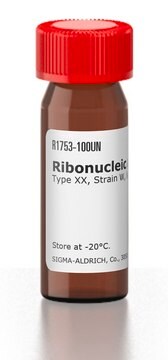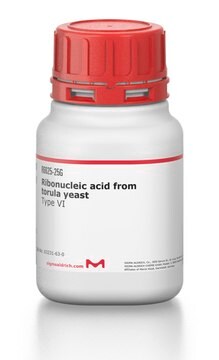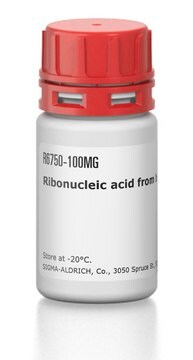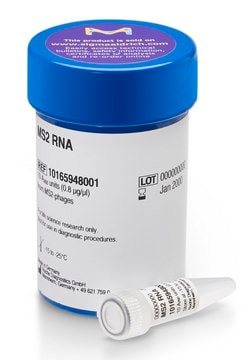R7876
Ribonucleic acid, transfer from wheat germ
Type V, 15-19 units/mg solid
Synonym(s):
Transfer RNA, tRNA
Sign Into View Organizational & Contract Pricing
All Photos(3)
About This Item
Recommended Products
grade
for molecular biology
Quality Level
type
Type V
form
lyophilized powder
specific activity
15-19 units/mg solid
storage condition
desiccated
solubility
H2O: ~2 mg/mL, clear to hazy
storage temp.
2-8°C
Looking for similar products? Visit Product Comparison Guide
General description
Wheat germ tRNA contains many different specific tRNA molecules.
Application
Crude transfer RNA (tRNA), purified from wheat germ, contains many specific tRNA molecules that can be separated by different processes. Experiments for detailed investigation of structure and function using in vitro translation systems often require highly purified tRNA, which can be achieved by combinations of chromatographic separations and reversible biochemical modification of the tRNA. Wheat germ tRNA has been used for the purification of RNAse Z (tRNA 3′- processing endonucleases) from wheat germ. The purification included six steps with the most efficient one using an affinity column made of wheat germ tRNA, which the RNAse Z bound tightly.
Suitable for use as a carrier in nucleic acid purification and precipitation.
Components
tRNA is provided as a lyophilized powder that is soluble in water at a concentration of 2 mg/ml.
Unit Definition
One unit will yield an absorbance of 1.0 at 260 nm in 1.0 mL of water (1 cm light path).
replaced by
Product No.
Description
Pricing
Storage Class Code
11 - Combustible Solids
WGK
WGK 3
Flash Point(F)
Not applicable
Flash Point(C)
Not applicable
Personal Protective Equipment
dust mask type N95 (US), Eyeshields, Gloves
Certificates of Analysis (COA)
Search for Certificates of Analysis (COA) by entering the products Lot/Batch Number. Lot and Batch Numbers can be found on a product’s label following the words ‘Lot’ or ‘Batch’.
Already Own This Product?
Find documentation for the products that you have recently purchased in the Document Library.
Customers Also Viewed
Spatial and temporal expression of the zebrafish genome by large-scale in situ hybridization screening.
Bernard Thisse et al.
Methods in cell biology, 77, 505-519 (2004-12-18)
Christine Thisse et al.
Nature protocols, 3(1), 59-69 (2008-01-15)
The in situ hybridization (ISH) technique allows the sites of expression of particular genes to be detected. This protocol describes ISH of digoxigenin-labeled antisense RNA probes to whole-mount zebrafish embryos. In our method, PCR-amplified sequence of a gene of interest
Christèle Maison et al.
Nature genetics, 30(3), 329-334 (2002-02-19)
Post-translational modification of histone tails is thought to modulate higher-order chromatin structure. Combinations of modifications including acetylation, phosphorylation and methylation have been proposed to provide marks recognized by specific proteins. This is exemplified, in both mammalian cells and fission yeast
Yana P Blokhina et al.
PLoS genetics, 15(1), e1007730-e1007730 (2019-01-18)
Meiosis is a cellular program that generates haploid gametes for sexual reproduction. While chromosome events that contribute to reducing ploidy (homologous chromosome pairing, synapsis, and recombination) are well conserved, their execution varies across species and even between sexes of the
Crystal E Fagan et al.
Proceedings of the National Academy of Sciences of the United States of America, 110(24), 9716-9721 (2013-05-01)
After four decades of research aimed at understanding tRNA selection on the ribosome, the mechanism by which ribosomal ambiguity (ram) mutations promote miscoding remains unclear. Here, we present two X-ray crystal structures of the Thermus thermophilus 70S ribosome containing 16S
Our team of scientists has experience in all areas of research including Life Science, Material Science, Chemical Synthesis, Chromatography, Analytical and many others.
Contact Technical Service









